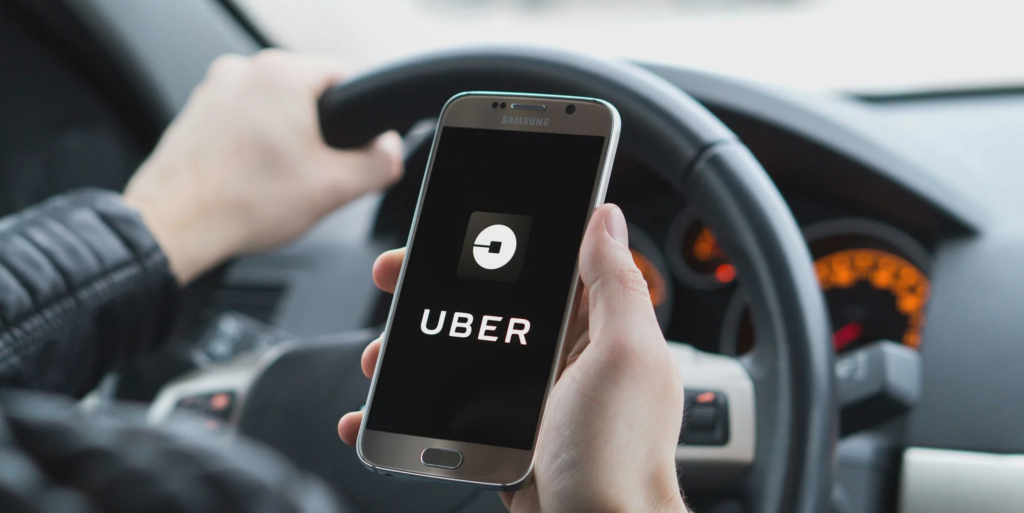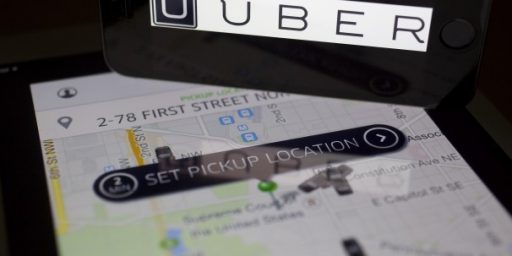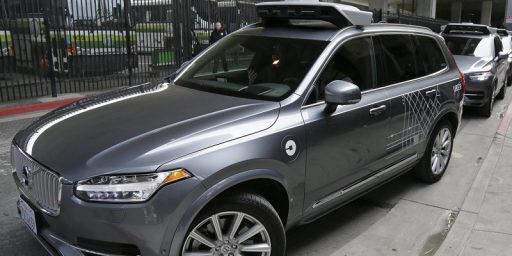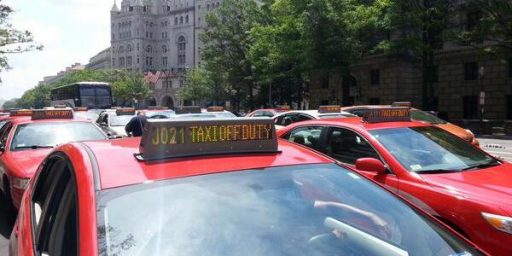New York City Cracks Down On Uber And Lyft
In an obvious effort to pander to the city's taxi industry, New York City is placing new limits on ride-sharing services such as Uber and Lyft.

New York City is cracking down on Uber and Lyft, and many people, including members of minority groups that have benefited from the services as both drivers and passengers, are speaking out:
New York became the first major American city on Wednesday to halt new vehicle licenses for ride-hail services, dealing a significant setback to Uber in its largest market in the United States.
The legislation passed overwhelmingly by the City Council will cap the number of for-hire vehicles for a year while the city studies the booming industry. The bills also allow New York to set a minimum pay rate for drivers.
Uber has become one of Silicon Valley’s biggest success stories and changed the way people across the globe get around. But it has faced increased scrutiny from government regulators and struggled to overcome its image as a company determined to grow at all costs with little regard for its impact on cities.
New York’s move to restrict the number of ride-hail vehicles and to establish pay rules for drivers — another step no other major city has taken — could provide a model for other governments that want to rein in the industry. New York’s aggressive stance also raises questions over how fast Uber can continue to grow as the company, which has been valued at $62 billion, plans to move toward an initial public offering next year.
The proposal to cap ride-hail companies led to a clash among interest groups with taxi industry officials saying the companies were dooming their business and Uber mounting a major advertising campaign to make the case that yellow cabs have a history of discriminating against people of color.
Mayor Bill de Blasio and Corey Johnson, the City Council speaker, said the bills will curtail the worsening traffic on the streets and improve low driver wages.
“We are pausing the issuance of new licenses in an industry that has been allowed to proliferate without any appropriate check or regulation,” Mr. Johnson said before the vote, adding that the rules would not diminish existing service for New Yorkers who rely on ride-hail apps.
Mr. de Blasio praised the bills and said he planned to sign them into law. The cap on new for-hire vehicles would take effect immediately.
“More than 100,000 workers and their families will see an immediate benefit from this legislation,” Mr. de Blasio said, referring to the city’s army of for-hire drivers. “And this action will stop the influx of cars contributing to the congestion grinding our streets to a halt.”
But Uber has warned its riders that the cap could produce higher prices and longer wait times for passengers if the company cannot keep up with the growing demand. Ride-hail apps have become a crucial backup option for New Yorkers swept up in the constant delays on the city’s sputtering subway, as happened on Wednesday when signal problems again snarled train lines across a large swath of the city. Ride-hail services have also grown in neighborhoods outside Manhattan where the subway does not reach.
Interestingly, Uber and Lyft found seemingly unlikely allies among civil rights activists, who argue that the companies provide a service to minority communities that both mass transit and the city’s taxi industry does not:
As president of the New York Urban League, Arva Rice often relies on ride-hailing apps such as Uber and Lyft to reach her home in Harlem after late-night events.
“I have been passed up by yellow taxis on numerous occasions,” explained Ms. Rice, who is black. “When you live in Harlem or Bed-Stuy, getting home is harder than it should be.”
Black and Latino New Yorkers — and those who live in the boroughs outside Manhattan — have long said they are not served well by yellow taxis. Now, a proposal by the City Council to place a one-year freeze on for-hire vehicle licenses is being opposed as a civil rights issue by organizations such as the National Urban League, the National Action Network and the N.A.A.C.P.
“I’m trying to get to work, I’m trying to get to school — I want somebody that’s going to pick me up,” the Rev. Al Sharpton told an audience on Saturday at the Harlem headquarters of his organization, the National Action Network.
“Some yellow cabs won’t even go uptown or to parts of Brooklyn,” Mr. Sharpton later said in an interview. “If you are downtown they won’t stop.”
(…)
The Rev. Dr. Johnnie M. Green Jr., the pastor of Mount Neboh Baptist Church in Harlem and president of a statewide clergy organization, said he recently had trouble getting a yellow taxi at La Guardia Airport to take him where he wanted after he had returned from Georgia.
“It’s a racial issue,” Mr. Green said. “The people that champion the crusade against Uber do not have a problem hailing yellow cabs.”
This latest move by New York City is just the latest example of the issues that Uber and Lyft specifically, and other ride-sharing companies, have been forced to deal with in major cities in the United States and around the world. Without fail, the efforts to restrict the ability of ride-sharing drivers to operate in large cities have been led, or come at the urging, of the owners and lobbyists for the taxi industry in those particular cities. This is an industry has been particularly active in New York City due in no small party that the medallions that permit taxi drivers and the owners of taxi companies pay for in order to be able to pick up fares in the city are quite expensive, reaching prices as high as $1,000,000 per license in recent years. Understandably, the taxi industry sees the ride-sharing companies as competitors and it isn’t surprising that they have resisted efforts by those companies to move into urban areas.
Ultimately, New York City reached a compromise on the ride-sharing issues that addressed at least some of the taxi industry’s concerns. For example, in order to be able to pick up fares in at least certain areas of the city, ride-sharing drivers must register with the city’s Taxi and Limousine Commission and be approved for a license to pick up app-requested fares in the city. Drivers without such licenses, or from neighboring jurisdictions such as New Jersey, are still allowed to drop passengers off, but they are not permitted to pick up passengers even if those passengers are headed back out of the city. As a result, a trip into downtown Manhattan for a New Jersey-based Uber driver ends up being a massive waste of time even if the initial trip into the city did pay well.
Despite these limitations, both Uber and Lyft have proven to be very successful and popular in major cities like New York. One of the many reasons for that is the one addressed by the civil rights leaders noted above, the fact that ride-sharing drivers have proven to be far more willing to travel into minority-dominated areas of the city, have generally not practiced the kind of subtle racism that taxi drivers are often accused of when they ignore hails from members of minority groups, and that they have proven to be far more willing to travel outside Manhattan into the outer boroughs of the city such as Queens, Brooklyn, the Bronx, and Staten Island, as well as to areas of Long Island that most New York City cabs would not travel to. Additionally, these ride-sharing gigs have proven to be a means for members of minority groups to work for themselves, either as a primary job or as a secondary one that brings in extra cash.
As for the city’s objection that the ride-sharing drivers are adding extra traffic to an already crowded downtown, Jazz Shaw addresses that quite well:
The city leadership is also claiming that the roads are too congested with all of these ride-hailing cars running around. But that claim is the most easily batted away. If you add another thousand yellow cabs to the current count you would indeed have another thousand cars clogging the streets. But the Uber and Lyft drivers are local residents using their own cars. Those cars, in nearly all cases, were already on the streets. Yes, the traffic in the Big Apple is a nightmare. Believe me… I’ve lived with it. But it was that way long before Uber came to town and a few thousand new drivers isn’t a drop in the bucket to a city of more than eight million people and who knows how many tourists every day.
This is yet another gift being given to the taxi companies, their unions and their powerful lobbyists. These groups are being crushed by the superior service that drivers using ride-sharing apps offer and they don’t like that a bit. Since they donate plenty of money to New York City politicians, they have some favors coming and this seems to be one of them.
Jazz is largely correct here. Notwithstanding the justifications being offered by Mayor DeBalsio, what’s going on here is obviously an effort on the part of the well-connected taxi industry to limit what is clearly a threat to them. They could, of course, respond to this by adapting on their own — some have suggested, for example, that taxi companies could develop mobile-based apps of their own that would allow riders to hail cabs and find their location in real-time. Instead, they find it easier to use their power and influence with the city government to restrict the competition. This isn’t a new story, of course. American history is replete with examples of businesses at the national, state, and local level that use their political financial influence to restrict competition and provide benefits and protections for themselves. In the end, it is the taxpayer and the consumer that ends up paying the price for that, and that’s exactly what will happen in New York and other cities that try to contain the rise of new forms of business and the so-called “gig economy.”





Simply raise the cap on taxis to 50,000. City makes money by selling medallions, taxis can’t afford to pass on fares anymore, communities get served by safe and regulated drivers.
It’s not that simple. The drivers simply refuse rides to minorities or people who want to go “too far.”
This is why, before there was Uber, Lyft, or even smartphones, New York City had the so-called “gypsy cab” industry that operated below the radar.
Then there’s Kevin Drum’s take,
Good thing this cap didn’t come out in time to save Michael Cohen’s taxi business.
@Doug Mataconis: They will stop refusing rides if there are more cabs than customers. If you’re no longer guaranteed a ride down the block you get less picky.
@Mu:
Perhaps, but the issue there is the same as it is with regard to Uber and Lyft. The taxi industry has long opposed expansion of the number of medallions because they see it (correctly) as a threat to the value of their franchises. Given the political power they have in New York City they have consistently been able to block such measures.
For sure, but pointing out their self-serving hypocrisy doesn’t tell us much about the merits of the underlying arguments. Yes, the current price of ride-shares is too low for drivers to make a living wage – my brother drives for Uber, so I’m well-aware of that reality – but over time, that fact will likely reduce the number of people willing/able to work as drivers, pushing the price up to a new, higher equilibrium. The transition period is definitely going to be painful for the drivers caught up in it (particularly legacy cab drivers), but the way to ameliorate that pain is through broadly-applicable social safety net policies, not industry-specific regulations that distort the market in favor of existing stakeholders.
I have a great deal of sympathy for taxi drivers. . . in London or in Las Vegas where taxis are clean, well-maintained, and generally driven by professionals.
I have zero sympathy for NYC taxis which are almost invariably filthy and driven by surly louts who can’t find the Empire State building and disappear at the first sign of rain or a black man. The only worse taxis are in LA where quite frankly the entire fleet (and their nasty, cretinous drivers) should be dropped into the Pacific to make a nice reef. These taxi companies treat customers with utter contempt, and then whine when the customers go elsewhere. Screw ’em.
@R. Dave:
Isn’t that in effect the same argument Republicans have been making for decades, during which we’ve seen effectively zero net wage growth? The invisible hand seems to have fallen asleep.
@R. Dave:
I entirely agree. And if they had a drivers’ union in a healthy job market, this wouldn’t even be an issue.
I didn’t have any particular point except that I remembered Kevin Drum’s position being a little different than just new tech Uber v old Yellow Cabs. This is a microcosm of what we should be looking at as THE political question of the 21st Century. In 1900 something like half the population was engaged in food production, now its, IIRC, a low single digit percentage. Why? Because we got really good at producing food so all those people shifted to industrial and service jobs. Now we’re getting really efficient at manufacturing, and more efficient in services. Where do those people go? The real problem here is that there are too many people who need a job bad enough to take what little Uber pays. And Uber wants to get rid of even those jobs with self driving cars.
This is only accurate if the residents were previously driving around, mostly to popular locations, for sport all day.
In actuality, the cars were previously parked most of the time.
Uber and Lyft do increase the number of cars actually using the streets at any given moment. (They also improve the parking situation.)
@Doug Mataconis:
It’s not even that simple. Economics plays into the racial issues — there are a lot of neighborhoods where it is going to be difficult to get a fare for the return trip, so there’s an economic incentive to avoid those neighborhoods. Plus racism.
Also, there is minimal feedback on an individual driver who ignores black fares in favor of the white guy up the street. With Uber and Lyft, there is a penalty for declining a fair, as the driver isn’t their own boss, and the company monitors this behavior.
All of which leads to the great David Letterman stunt where he demonstrated that it was harder for a black man to hail a taxi than it was for a man in a bear suit.
Note that Uber solves this problem only for people who have smart phones.
Now, gypsy cabs aren’t altruistically serving an underserved demographic. They are skirting around the laws, without the insurance and licenses, taking what they can get because they are desperate. Given a choice between a poorly paying job and no job, people vote with their stomachs.
Seattle attempted to. Uber entered the market here illegally, as they do, and when the Seattle city council passed legislation legalizing it with restrictions, Uber sponsored a referendum that would open the doors more.
I am disappointed that this did not result in police requesting Uber drivers and then arresting them when they show up for operating taxis without a license.
Taxis and car services are part of the overall transportation infrastructure plan, so that makes sense on the surface, but the cat is pretty much out of the bag on this one.
I do think that requiring the dispatch service to guarantee a minimum wage seems like a good idea though. There would be some issues with drivers who sign up with multiple services, but right now they are signing out on Lyft while taking a fare from Uber, so at least they are easy to identify. But, it’s a complication I don’t have an immediate answer to.
Odd, the whole racialised aspect à l’américaine.
Of more structural interest is the simple economic reality that neither Uber nor Lyft make actual sense as economic plays unless their end-game is monopoly, as neither come close to break-even on operational cost to price. They are both engaging in massive investor capital subsidy to achieve monopoly (or irrationally waste capital if you don’t believe achieve monopoly).
The people I’ve known who drove Uber quit after a few months when they figured out they were making less than $4/hr.
Also yeah the investor subsidy is huge, the customer’s payment for an Uber ride is something like 40% of the cost of the ride. I wish I didn’t have a car right now, I’d Uber everywhere until they inevitably go bankrupt a few months/years from now.
@Lounsbury: I think it’s very nice that venture capitalists choose to subsidize my transportation to and from places where it is just a nuisance to park or where I might get drunk.
A lot of my friends are in the “Oh, Uber is so horrible, I would never use them” camp, and while I can see their arguments (Uber does horrible things, and is amazingly sexist inside), this is exactly why I choose them over The others. I want to help them lose money.
@Gustopher: It’s nice to the extent it does not
The public policy issue is dual – while the investor subsidy play for monopoly goes on, is there a naive cheerleading (as in DM’s post really) leading to distortion of the market and if it were to succeed, what end resolution.
The capital destruction is somewhat depressing, but such is life.
I am shocked…SHOCKED!! I SAY…to see Progressive Democrats implement policies that actively hurt poor people of color.
@Doug Mataconis: I agree with this. I used to live in an East Coast city with a thriving taxi business, but I lived in a predominantly minority neighborhood, and had difficulty getting cabs when I needed one. I often used the gypsy cabs for this reason. (This was before the days of Uber and Lyft).
Now I live in a West Coast city where cab service is virtually non-existent. Uber and Lyft have been a godsend.
The leaders of NYC just threw free enterprise under the bus.
Next they will put limits the kids’ lemonade stands: 5 cups per day.